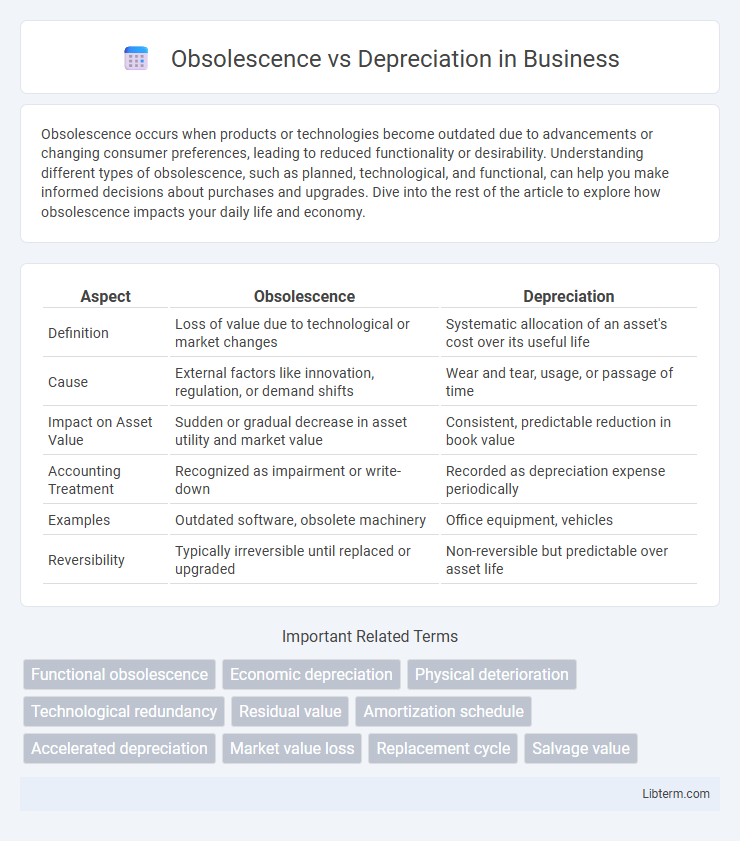Obsolescence occurs when products or technologies become outdated due to advancements or changing consumer preferences, leading to reduced functionality or desirability. Understanding different types of obsolescence, such as planned, technological, and functional, can help you make informed decisions about purchases and upgrades. Dive into the rest of the article to explore how obsolescence impacts your daily life and economy.
Table of Comparison
| Aspect | Obsolescence | Depreciation |
|---|---|---|
| Definition | Loss of value due to technological or market changes | Systematic allocation of an asset's cost over its useful life |
| Cause | External factors like innovation, regulation, or demand shifts | Wear and tear, usage, or passage of time |
| Impact on Asset Value | Sudden or gradual decrease in asset utility and market value | Consistent, predictable reduction in book value |
| Accounting Treatment | Recognized as impairment or write-down | Recorded as depreciation expense periodically |
| Examples | Outdated software, obsolete machinery | Office equipment, vehicles |
| Reversibility | Typically irreversible until replaced or upgraded | Non-reversible but predictable over asset life |
Understanding Obsolescence and Depreciation: Key Differences
Obsolescence occurs when an asset loses value due to technological advancements or changes in market demand, rendering it outdated or less useful, while depreciation refers to the systematic allocation of an asset's cost over its useful life based on wear and tear. Obsolescence affects the asset's relevance and functionality, often unpredictable, whereas depreciation follows a planned accounting method such as straight-line or declining balance. Understanding these differences is crucial for accurate financial reporting, asset management, and strategic replacement decisions.
Types of Obsolescence in Modern Assets
Types of obsolescence in modern assets include technological obsolescence, where rapid innovation renders equipment or software outdated, and functional obsolescence, involving loss of utility due to design flaws or changing user needs. Economic obsolescence occurs when external factors like market shifts or regulatory changes reduce asset value without physical alteration. Understanding these obsolescence types is essential for accurate asset valuation and effective depreciation strategies in industries reliant on high-tech and specialized equipment.
Depreciation Methods and Their Impacts
Depreciation methods such as straight-line, declining balance, and units of production significantly impact asset valuation and financial reporting by allocating the asset's cost over its useful life in different patterns. Straight-line depreciation evenly spreads expense, resulting in consistent profit margins, whereas declining balance accelerates expense recognition, lowering taxable income earlier. Units of production ties depreciation to actual usage, offering precise matching of expenses to revenue for assets with variable productivity.
Causes of Asset Obsolescence in Today’s Economy
Asset obsolescence in today's economy primarily stems from rapid technological advancements, changing consumer preferences, and evolving regulatory standards. Innovations such as automation and digitalization make existing equipment and systems outdated, while shifts in market demand render products and machinery less viable. Environmental regulations and sustainability initiatives further accelerate obsolescence by imposing stricter compliance requirements on older assets.
How Depreciation Affects Financial Statements
Depreciation impacts financial statements by systematically allocating the cost of tangible assets over their useful lives, reducing the asset's book value on the balance sheet. On the income statement, depreciation appears as an expense, lowering taxable income and net profit during each accounting period. This allocation reflects asset wear and tear, contrasting with obsolescence, which relates to asset value loss due to technological or market changes rather than physical deterioration.
The Relationship Between Obsolescence and Depreciation
Obsolescence directly impacts depreciation by accelerating the reduction in an asset's value beyond normal wear and tear, leading to faster write-downs on financial statements. Technological advancements and market changes cause obsolescence, which shortens an asset's useful life and increases depreciation expense. Understanding this relationship enables accurate asset valuation and effective financial planning.
Technological Advancements: Accelerating Obsolescence
Technological advancements rapidly accelerate obsolescence by rendering equipment and software outdated before the end of their physical lifespan, unlike depreciation which allocates asset cost over time based on usage or wear. Innovations in technology, such as new hardware capabilities or software updates, shorten product relevance and market value, causing premature obsolescence. Companies face increased financial impact as assets lose functional utility faster than accounting depreciation schedules predict.
Managing Asset Value: Strategies for Businesses
Effective management of asset value requires understanding the differences between obsolescence and depreciation. Depreciation accounts for the gradual wear and tear or usage-based reduction in an asset's value, while obsolescence recognizes the loss of value due to technological advances or market changes rendering the asset outdated. Businesses can strategically extend asset value by implementing regular maintenance, timely upgrades, and investing in adaptable technologies to mitigate obsolescence and control depreciation costs.
Accounting Standards: Recording Obsolescence vs Depreciation
Accounting standards define depreciation as the systematic allocation of an asset's cost over its useful life, reflecting wear and tear or usage. Obsolescence, often considered in impairment tests under standards like IFRS IAS 36 or US GAAP ASC 360, requires recognition of an asset's diminished value due to technological advancements or market changes, leading to write-downs. Proper recording distinguishes depreciation as a planned expense, while obsolescence triggers immediate impairment losses, impacting financial statements differently.
Future Trends: Navigating Asset Obsolescence and Depreciation
Future trends in navigating asset obsolescence and depreciation emphasize integrating predictive analytics and AI-driven maintenance to extend asset lifecycles and optimize value. Companies increasingly adopt real-time data monitoring and adaptive financial models to anticipate technological advancements and market shifts, minimizing unexpected write-offs. Embracing circular economy principles and modular asset designs enables sustainable asset management by reducing both physical obsolescence and accelerated depreciation.
Obsolescence Infographic

 libterm.com
libterm.com